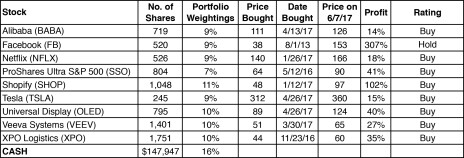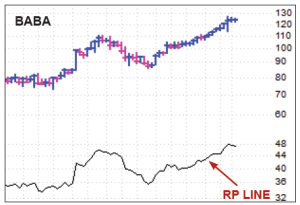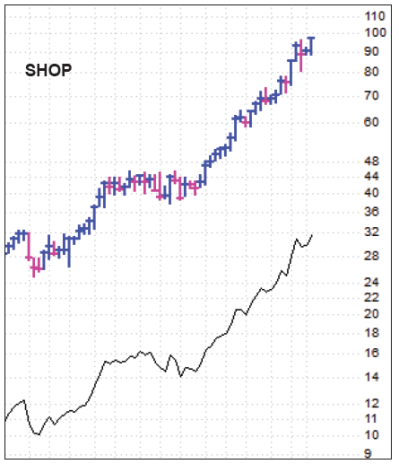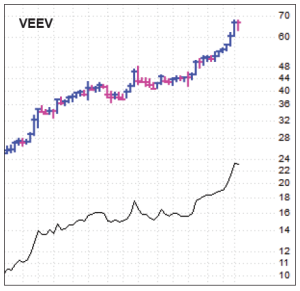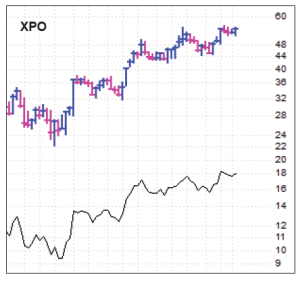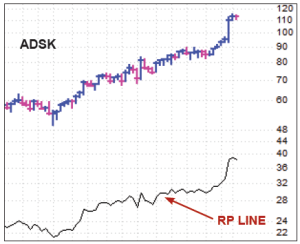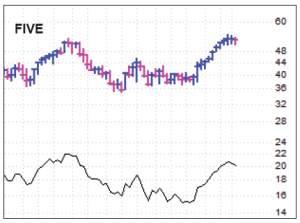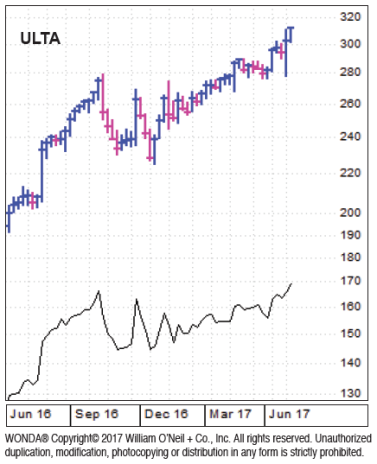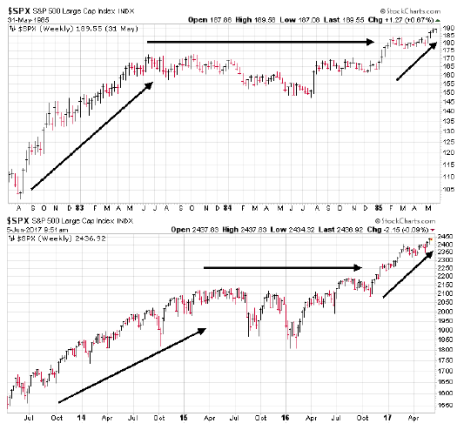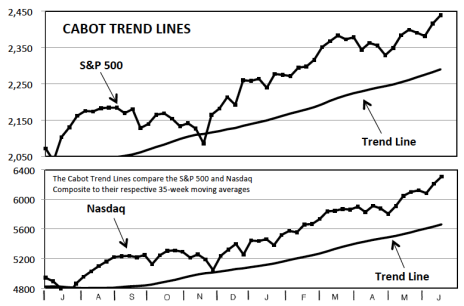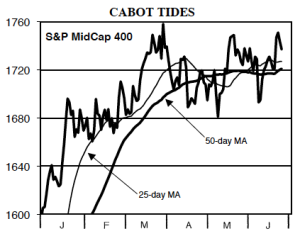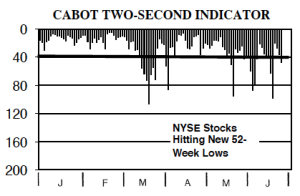We’re restoring Buy ratings on a couple of stocks, and averaging up in one of them as it has begun to emerge from a multi-month rest period. That said, we’re still holding about 14% in cash given the iffy broad market and the many divergences in the market.
Cabot Growth Investor 1369
[premium_html_toc post_id="134882"]
Often the Best Thing to Do is Nothing
Many years ago, we read a study that examined the stress investors felt under various scenarios. Contrary to what most think, the scenario that caused the least stress was when a stock fell slowly after the initial buy; investors generally remained confident in their initial analysis and thought the stock was a better buy as it slipped.
Conversely, what caused the most stress? Volatility! Specifically, when a stock fell quickly or rose rapidly soon after the buy, investors tended to fret about the money they were losing or they viewed the sharp upmove as unsustainable. We know from our own experience that this is true—when the market and individual stocks make dramatic moves, human nature tells us to do something equally dramatic.
That’s what we’re seeing today. The major moves by a bunch of growth stocks since mid-April has some investors piling in and many others taking profits. But our preferred path is to do nothing until the evidence tells us to. As Jesse Livermore explained, it’s often the sitting that makes the big money for you.
On that note, the market environment has remained mostly the same during the past few weeks. Our Cabot Tides have flipped back to positive, which is a plus, but the market’s longer-term trend and the action of growth stocks both remain excellent, while most of the market is just OK and parts of the broad market are iffy. (Longer-term, we continue to think the market could have a way to go; see our 7.5% Rule update on page 6.) With the evidence not much changed, we’re not making any drastic moves.
Of course, that doesn’t mean we’re not thinking ahead and putting together plans should something change; we always plan so we’re prepared to act quickly once things change (which they eventually will). And it also doesn’t mean some changes around the edges aren’t worthwhile—we have many stocks now rated Buy, and we’re averaging up on one stock tonight.
But at the end of the day, we’re trend followers, not trend predictors, and right now, the trend for growth stocks is solid. Thus, we continue to enjoy the party and look for new opportunities as they emerge—but we’re also keeping our eyes open should things change.
[highlight_box]WHAT TO DO NOW: Remain mostly bullish. In the Model Portfolio, we’re averaging up in XPO Logistics (XPO) tonight and are placing some stocks back on Buy, though we’re also holding around 14% in cash, given the so-so action from most of the market. Details below.[/highlight_box]
Model Portfolio Update
Growth stocks have had another couple of great weeks, with a few dozen leaders lighting up the charts in recent weeks. Happily, we own more than a few of them, pushing the Model Portfolio up nicely.
While we’ve yet to see any major intermediate-term red flags, it’s important to keep your feet on the ground and have a plan for what you will do when the market as a whole pulls back or if we see some rotation into other sectors—plan for a rainy day when it’s sunny outside.
Still, as we wrote above, it’s best to take things as they come, and right now we’re not only seeing strong growth stocks move higher, but also a few stocks from other sectors joining the parade. One of them, XPO Logistics, we’ve owned for a while and we’re averaging up in it today.
Current Recommendations
BUY—Alibaba (BABA 126)—Alibaba seems to be strengthening its position in China’s take-out ordering and delivery market, leading a fresh round of fundraising for Ele.me, one of three leading services in that country. Still, the main focus here remains on the company’s ever-expanding e-commerce and cloud computing opportunities, which have analysts regularly nudging up their earnings estimates (up 28% this year and 29% in 2018). The stock has quieted down nicely since its post-earnings shakeout and recovery, which is encouraging. Bigger picture, BABA has shown unusual persistence, rising 14 of the past 15 weeks, a clear sign of steady institutional accumulation. Short-term, a pullback or some further sideways action is possible (and could even be healthy), but such a steady string of buying usually leads to higher prices down the road. Sit tight if you own some, and if you don’t, try to buy on dips of two or three points.
HOLD—Facebook (FB 153)—FB looks fine, having nudged out to new price highs this week on light volume, though the relative performance (RP) line is still a bit shy of virgin turf. One interesting data point released this week was that Sony said it has sold one million of its PlayStation virtual reality headsets since last fall; that’s well ahead of Facebook’s Oculus, but we’re encouraged by it, seeing it as a sign that the coming virtual reality boom is likely closer than most expect. In the near-term, the company is still all about advertising on Facebook and Instagram, which is doing well. FB isn’t the strongest stock in the market, and for that reason, we’ll stay on Hold at this time. But it remains a flag-bearer of the bull market (we think it’s similar to Apple in the mid- to late-2000s and Cisco back in the bubble days—one of the top two or three go-to names for big investors), and the fundamental story still has lots of upside. If you own some, sit tight.
BUY—Netflix (NFLX 166)—One of the underrated aspects of Netflix’s business is that it’s both growing rapidly and should prove relatively resistant to economic pressures—$10 per month (or the international equivalent) is hardly a heavy pull, and people tend to stay in more when times are tough, which could actually play into Netflix’s hands. That’s not to say there aren’t other threats (like competition) or risks (the company is spending a mind-boggling $6 billion on original content this year alone!), but it’s a unique situation that adds reliability to the firm’s long-range forecasts. As for the stock, it remains in a solid uptrend, thanks in part due to some bullish analyst chatter about international subscriber growth. We continue to think NFLX is a good buy around here or on dips of a couple of points.
BUY—ProShares Ultra S&P 500 Fund (SSO 90)—In the last issue, we wrote, “we hope (our sale of half our shares is) a “bad” sale and that the market kites higher from here, which will not only help our remaining shares of SSO but, most likely, our strong stocks, too.” That’s exactly what happened, as SSO has pushed out to new highs and the rest of our growth stocks have gone vertical. We’re still a bit worried about the market’s crosscurrents and divergences that could eventually lead to some trouble, but there’s no question that the major trend is up, with the S&P’s recent push out of a three-month consolidation a positive sign. If you don’t own any, you can take a position here (and use an initial loss limit around 85) to get a foothold in the bull market.
BUY—Shopify (SHOP 97)—SHOP has been one of the market’s biggest leaders all year, and the recent action has been very encouraging—after a share offering-induced shakeout, the stock tightened up nicely and has since run to new highs. Beyond the firm’s quarter-by-quarter numbers, a big attraction here is that the company is a top player in helping home-based, small- and mid-sized businesses improve their operations online (and elsewhere), a gigantic opportunity that’s attracting some big fish—Fidelity owned 9.2 million shares of SHOP as of the end of March, while T. Rowe Price has 4.1 million shares. (The total share count is around 97 million after the recent offering.) We can’t say SHOP is at an ideal entry point, but the stock’s refusal to give back much of its year-to-date advance is a good sign. We’ll go back to Buy, but if you’re starting out, we’d advise starting with a smaller-than-normal position and use a loss limit in the mid-80s.
BUY—Tesla (TSLA 360)—For a stock that most would agree is revolutionizing a major industry, sentiment toward TSLA remains surprisingly subdued, if not bearish—31.7 million shares are still sold short, and of the 24 analysts that follow the stock, just seven have Buy ratings, with 11 Holds and six Sells! We’re obviously bullish, mainly because of the company’s improving fundamental outlook (as production booms and the Model 3 hits the assembly lines next month) and the big-picture chart pattern (TSLA only recently emerged from a two-and-a-half-year consolidation). And if some of those bears turn positive (or at least neutral), it should further boost the stock. We filled out our position last week when TSLA rallied out of its six-week rest area to new highs. As with most stocks, a pullback could come, but given the recent big volume buying, we’d expect dips to find support. We’ll stay on Buy.
BUY—Universal Display (OLED 124)—Universal Display has acted very well since its earnings gap in early May, first tightening up for three weeks, and then pushing to new highs on excellent volume this week. As we’ve written before, there’s definitely boom and bust potential with OLED, so we’ll be looking for any updates (possibly during next month’s earnings season) regarding plans and capacity expansions from display manufacturers going forward. As it stands now, the odds favor Universal’s materials and licensing business surging for the next few years as the display industry moves to organic light emitting diodes. You could nibble here or look for dips toward the 25-day line (now at 114 and rising quickly).
BUY—Veeva Systems (VEEV 65)—Veeva continues to bask in the glow of its excellent quarterly report from two weeks ago. We think that, beyond just the better-than-expected quarterly results (sales up 32%, earnings up 47%), what’s driving the stock is the realization by more big investors that Veeva likely has a lot of “built-in” growth ahead of it. Among its CRM products, for instance, it has the opportunity to sell another 150,000 seats just among its current customer base, and it’s nearly a sure thing that the firm’s various Vault products (it has 14 total) has a lot of upside both within and outside of life sciences. As for the stock, we have seen some signs of climax action—VEEV first broke out a year ago, and its pre- and post-earnings action was very euphoric (up 25% in three weeks), which bears watching. That’s something to keep in mind should we see some abnormal weakness in the near future, which could cause us to take a few chips off the table. At this point, though, the climax action is more of a heads-up. We’ll stay on Buy, but new buying should be kept small and on pullbacks.
BUY—XPO Logistics (XPO 60)—We’re not huge proponents of diversification, but we do think it’s best not to own all “fastballs” even when the market is hot, like today—instead, owning some liquid leaders (like BABA and FB, which are a bit less volatile) and some growth ideas outside of technology, like XPO, can give your portfolio a little balance. This week, XPO has come to life after one analyst said the stock has potentially huge upside as the company is well positioned for the continuing e-commerce boom. We think this lift to new highs might mark the end of what’s effectively been a six-month up-and-down period (the stock was 50 in early December, and was at 52 last week). We’ll go back to Buy and will average up here, buying 20% additional shares. We still see big upside potential as the free cash flow story plays out.
Watch List
Five Below (FIVE 53): FIVE rallied 11 weeks in a row and is now trading tightly in the low 50s, even after last week’s earnings topped expectations. We’re very keen on this cookie-cutter story. See below.
PayPal (PYPL 54): PYPL is a steadier stock, but it’s had a nice run since breaking out on earnings, and we believe the 20%-ish growth story can play out over many years as digital payments become the norm. See below for more.
ServiceNow (NOW 108): NOW’s persistent advance to new all-time highs is a good sign going forward, and the firm’s burgeoning free cash flow and lack of any comprehensive competition are positives. See below.
Other Stocks of Interest
The stocks below may not be followed in Cabot Growth Investor on a regular basis. They’re intended to present you with ideas for additional investment beyond the Model Portfolio. For our current ratings on these stocks, see Updates on Other Stocks of Interest on the subscriber website or email mike@cabotwealth.com.
Autodesk (ADSK 111) — Autodesk, the dominant provider of design software for engineers, has been going through some big changes as it transitions from a buy-the-bundle model to a cloud-and-subscription model. Losing that big, up-front payment in favor of monthly payments has disrupted revenue in the short run. But the small payment for new adopters is increasing subscription rates. The company’s Q1 earnings report showed 3.29 million subscriptions (up 22% from a year ago) of which 1.32 million were the so-called “new model” subscriptions. Those new-model subscriptions were up 21% from last quarter and up 104% from last year. ADSK, which had been in rally mode since early 2016, gapped up on triple volume on May 19 and has been holding on tightly to its gains.
Cheniere Energy (LNG 53) — Cheniere Energy and its massive Sabine Pass, Louisiana liquefied natural gas (LNG) terminal have a history that stretches back to the era when we all thought LNG imports would be the big story. Fracking changed all that, and Cheniere now has two LNG shipping terminals and a widening network of pipelines supplying U.S. natural gas for liquification and shipping. This was a big story during its romance phase back in 2013 and 2014, but it went through a rough transition when energy prices flagged. It looks like it might be time for a reality rally, as the company’s huge investments are starting to pay off in a big way, with sales and earnings soaring. The stock is set up well and could do well once energy stocks get going.
Five Below (FIVE 48) — Five Below runs a rapidly expanding string of stores—more than 500 stores in 32 states—aimed at younger shoppers, where all the merchandise is priced at $5 or below. The store’s skill at figuring out what teens want has driven revenue higher by more than 20% for four straight years, and lets the company achieve 90% payback on the cost of new stores in the first year. FIVE has spent a lot of time since its IPO in 2012 trading between 35 and 45 (with occasional excursions above 50 and below 30. But the feat FIVE pulled off from March to May, when it headed higher for 11 straight weeks, is strong evidence of persistent institutional buying. The stock is now right on the threshold of a new all-time high, which might be the prelude to a breakout.
Ulta Beauty (ULTA 308) — Ulta Beauty operates a successful string of 990 beauty supply stores that sell name brand cosmetics, other products and salon haircare services. Its stores and online catalogue list over 20,000 items from 500 different manufacturers. The company’s strict adherence to its cookie-cutter strategy has produced six straight years of 20% revenue growth. ULTA was a hotter stock a few years ago when it was relatively newer story, but the stock has been a steady performer since it emerged from a two-year consolidation from mid-2012 to mid-2014. Interestingly, ULTA dipped from 300 to 280 just ahead of earnings, but bounced right back to its former trend line. This isn’t a super strong stock, but it’s likely to remain a steady performer.
Update on Our 7.5% Rule (and the 1985 Precedent)
We unveiled our 7.5% Rule a little over two months ago, which flashes anytime the S&P 500 closes a week at least 7.5% above its 35-week moving average for the first time in at least nine months. History shows that such a reading is a strong sign of positive momentum that’s likely to persist in the months ahead. The 7.5% Rule has flashed just 11 times since 1980, with the market sporting solid gains three, six and 12 months later.
The indicator’s latest signal—March 3 of this year—has now reached the three-month mark. And once again, the green light proved worthwhile, with the S&P 500 rising a bit more than 2.3% during the three-month stretch while the Nasdaq rose a strong 7.4%. Given that the average gain a year after a 7.5% signal was north of 15%, there’s reason to expect the bull market to continue.
What’s interesting is that these three-month results are most similar to the signal that occurred near the start of 1985—yet another of the many similarities between the two environments. Back then, the market ripped out of its secular (very long-term) bear market starting in August 1982, rallying for about a year and a half before topping out. That’s in the ballpark of the last couple of years, when the market left behind its 2000-2013 secular bear phase in May 2013 and ran up for about two years to its 2015 peak.
In the mid-1980s, the market then suffered a year-long, 15% deep correction and consolidation before blasting off in early 1985. In the recent scenario, the correction lasted 18 months but was also a relatively modest 15% downturn, ending with the post-election liftoff last November.
Even the action since the 7.5% Rule went into effect has looked similar, with the S&P moving sideways in a tight range for two-plus months in each occurrence before resuming its uptrend.
We never draw direct comparisons between market periods, so we’re not predicting the market is going to double during the next two years as it did from 1985 to 1987. But the chart action, the sentiment environment and, now, the action in the months since the 7.5% Rule Buy signal, all point to analogous forces being at work today.
Lots of Long-Term Breakouts
One of the most encouraging pieces of evidence we’ve seen in the past couple of months are long-term (multi-year) breakouts by more and more leading growth stocks.
For example, a big reason we added Shopify (SHOP) in January was its breakout from its huge 18-month post-IPO base, which has led to a terrific advance. Tesla (TSLA) is a more recent example after breaking free from the shackles of a giant 30-month up-and-down consolidation in April.
Two similar long-term breakouts have recently occurred in names we’ve played before, PayPal (PYPL) and ServiceNow (NOW). Look at how PYPL decisively gapped to new highs following earnings in April and has followed through nicely, notching seven weeks up in a row. Meanwhile, NOW spent two months building a shallow base near its highs from late-2015, and in recent weeks, it’s ripped ahead on big volume.
The appeal with these types of patterns (a big base, tightening action, a breakout and then upside follow through) is that the stocks are early in new uptrends. Barring a major market correction, the odds strongly favor the stocks working higher over time, and that the next pullback will be a good entry point.
Both PYPL and NOW are on our Watch List; we’re a bit more favorable toward NOW given its faster growth, but both look like high-odds plays if they consolidate or retreat during the next couple of weeks. WATCH.
Cabot Market Timing Indicators
This remains a bull market and growth stocks are still in good shape, but the short- to intermediate-term outlook is up in the air, with most indexes treading water and the broad market not in the best of health. We remain bullish but are holding some cash as we wait to see how things play out.
Cabot Trend Lines: Bullish
There’s still no sign of trouble with the market’s longer-term trend, as our Cabot Trend Lines remain firmly in the bullish camp. Last week, the S&P 500 closed 6.5% above its 35-week moving average, while the Nasdaq closed a large 11.4% above its own 35-week line! That was the widest spread since November 2013, so a pause or pullback certainly wouldn’t be uncalled for. But there’s no question the market’s long-term trend is still up.
Cabot Tides: Bullish
The market’s upmove during the past two weeks has been enough to push our Cabot Tides back into positive territory. Right now, four of the five indexes we track (including the S&P 400 MidCap, shown here) are far enough above their 50-day moving averages to conclude that the intermediate-term trend is up. We’d still like to see every index get in gear on the upside, but the positive Tides is another arrow in the bulls’ quiver.
Two-Second Indicator: Unhealthy
Since the start of May, the number of stocks hitting new lows has been north of 40 on 15 trading days out of 27 total. That’s not a horror show, and our Two-Second Indicator has seen its readings generally improve in recent days as stocks have rallied. But until we see a few straight days of shrinking new lows, the evidence points toward the broad market being iffy.
[premium_html_footer]
Send questions or comments to mike@cabotwealth.com.
Cabot Growth Investor • 176 North Street, Post Office Box 2049, Salem, MA 01970 • www.cabotwealth.com
All Cabot Growth Investor’s buy and sell recommendations are made in issues or updates and posted on the Cabot subscribers’ website. Sell recommendations may also be sent to subscribers as special bulletins via email and the recorded telephone hotline. To calculate the performance of the portfolio, Cabot “buys” and “sells” at the midpoint of the high and low prices of the stock on the day following the recommendation. Cabot’s policy is to sell any stock that shows a loss of 20% in a bull market (15% in a bear market) from our original buy price, calculated using the current closing (not intra-day) price. Subscribers should apply loss limits based on their own personal purchase prices.
Charts show both the stock’s recent trading history and its relative performance (RP) line, which shows you how the stock is performing relative to the S&P 500, a broad-based index. In the ideal case, the stock and its RP line advance in unison. Both tools are key in determining whether to hold or sell.
THE NEXT CABOT GROWTH INVESTOR WILL BE PUBLISHED JUNE 21, 2017
We appreciate your feedback on this issue. Follow the link below to complete our subscriber satisfaction survey: Go to: www.surveymonkey.com/marketlettersurvey
Neither Cabot Wealth Network nor our employees are compensated by the companies we recommend. Sources of information are believed to be reliable, but are in no way guaranteed to be complete or without error. Recommendations, opinions or suggestions are given with the understanding that subscribers acting on the information assume all risks. © Cabot Wealth Network. Copying and/or electronic transmission of this report is a violation of U.S. copyright law. For the protection of our subscribers, if copyright laws are violated, the subscription will be terminated. To subscribe or for information on our privacy policy, call 978-745-5532, visit www.cabotwealth.com or write to support@cabotwealth.com.
[/premium_html_footer]

